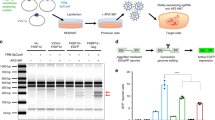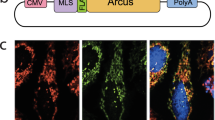Abstract
Peptide nucleic acids (PNAs) are synthetic polynucleobase molecules, which bind to DNA and RNA with high affinity and specificity. Although PNAs have enormous potential as anti-sense agents, the success of PNA-mediated gene therapy will require efficient cellular uptake and sub-cellular trafficking. At present these mechanisms are poorly understood. To address this, we have studied the uptake of biotinylated PNAs into cultured cell lines using fluorescence confocal microscopy. In human myoblasts, initial punctate staining was followed by the release of PNAs into the cytosol and subsequent localisation and concentration in the nucleus. To determine whether PNAs could also be used as therapeutic agents for mtDNA disease, we attempted to localise PNAs to the mitochondrial matrix. When attached to the presequence peptide of the nuclear-encoded human cytochrome c oxidase (COX) subunit VIII, the biotinylated PNA was successfully imported into isolated organelles in vitro. Furthermore, delivery of the biotinylated peptide-PNA to mitochondria in intact cells was confirmed by confocal microscopy. These studies demonstrate that biotinylated PNAs can be directed across cell membranes and to a specific sub-cellular compartment within human cells – highlighting the importance of these novel molecules for human gene therapy.
This is a preview of subscription content, access via your institution
Access options
Subscribe to this journal
Receive 12 print issues and online access
$259.00 per year
only $21.58 per issue
Buy this article
- Purchase on Springer Link
- Instant access to full article PDF
Prices may be subject to local taxes which are calculated during checkout





Similar content being viewed by others
References
Corey DR . Peptide nucleic acids: expanding the scope of nucleic acid recognition Trends Biotechnol 1997 15: 224–229
Demidov VV, Yavnilovich MV, Frank-Kamenetskii MD . Kinetic analysis of specificity of duplex DNA targeting by homopyrimidine peptide nucleic acids Biophysical J 1997 72: 2763–2769
Demidov VV et al. Stability of peptide nucleic acids in human serum and cellular extracts Biochem Pharmacol 1994 48: 1310–1313
Norton JC et al. Inhibition of human telomerase activity by peptide nucleic acids Nature Biotechnol 1996 14: 615–619
Hanvey JC et al. Antisense and antigene properties of peptide nucleic acids Science 1992 258: 1481–1485
Nielsen PE, Egholm M, Berg RH, Buchardt O . Peptide nucleic acids (PNAs): potential antisense and anti-gene agents Anti-Cancer Drug Des 1993 8: 53–63
Bonham MA et al. An assessment of the antisense properties of RNase H-competent and steric-blocking monomers Nucleic Acids Res 1995 23: 1197–1203
Wittung P et al. Phospholipid membrane permeability of peptide nucleic acid (corrected and republished with original paging, article originally printed in FEBS Lett 1995; 365: 27–29) FEBS Lett 1995 375: 27–29
Dowty ME, Wolff JA . Possible mechanisms of DNA uptake into skeletal muscle. In: Wolff JA (ed) Gene Therapeutics: Methods and Applications of Direct Gene Transfer Birkhauser: Boston 1994 pp 83–98
Chinnery PF, Turnbull DM . Mitochondrial medicine Q J Med 1997 90: 657–666
Taylor RW et al. Treatment of mitochondrial disease J Bioenerg Biomemb 1997 29: 195–205
Chinnery PF, Turnbull DM . The clinical features, investigation and management of patients with mitochondrial DNA defects J Neurol Neurosurg Psych 1997 63: 559–563
Larsson N-G, Clayton DA . Molecular genetic aspects of human mitochondrial disorders Ann Rev Genet 1995 29: 151–178
Attardi G, Yoneda M, Chomyn A . Complementation and segregation behavior of disease causing mitochondrial DNA mutations in cellular model systems Biochim Biophys Acta 1995 1271: 241–248
Chinnery P, Howell N, Lightowlers R, Turnbull D . Molecular pathology of MELAS and MERRF: the relationship between mutation load and clinical phenotype Brain 1997 120: 1713–1721
Gross NJ, Getz GS, Rabinowitz M . Apparent turnover of mitochondrial deoxyribonucleic acid and mitochondrial phospholipids in the tissues of the rat J Biol Chem 1969 244: 1552–1562
Chrzanowska-Lightowlers ZM, Lightowlers RN, Turnbull DM . Gene therapy for mitochondrial DNA defects: is it possible? Gene Therapy 1995 2: 311–316
Taylor RW, Chinnery PF, Turnbull DM, Lightowlers RN . Selective inhibition of mutant human mitochondrial DNA replication in vitro by peptide nucleic acids Nat Genet 1997 15: 212–215
Rizzuto R et al. A gene specifying subunit VIII of human cytochrome c oxidase is localised to chromosome 11 and is expressed in both muscle and non-muscle tissues J Biol Chem 1989 264: 10595–10600
Rapaport D, Neupert W, Lill R . Mitochondrial protein import: Tom40 plays an important role in targetting and translocation of preproteins by forming a specific binding site for the presequence J Biol Chem 1997 272: 18725–18731
Whittaker JE, Moore PL, Haugland RP . Dihydrotetramethylrosamine: a long wavelength, fluorogenic peroxidase substrate evaluated in vitro and in a model phagocyte Biochem Biophys Res Commun 1991 751: 387–393
Gewirtz AM, Stein CA, Glazer PM . Facilitating oligonucleotide delivery: helping antisense deliver on its promise Proc Natl Acad Sci USA 1996 93: 3161–3163
Good L, Nielsen PE . Antisense inhibition of gene expression in bacteria by PNA targeted to mRNA Nat Biotechnol 1998 16: 355–358
Gray GD, Basu S, Wickstrom E . Transformed and immortalized cellular uptake of oligodeoxynucleoside phosphorothioates, 3′-alkylamino oligodeoxynucleosides, 2-O-methyl oligoribonucleotides, oligodeoxynucleoside methylphosponates, and peptide nucleic acids Biochem Pharmacol 1997 53: 1465–1476
Kiss T, Filipowicz W . Evidence against a mitochondrial location of the 7-2/MRP RNA in mammalian cells Cell 1992 70: 11–16
Li K et al. Subcellular partitioning of MRP RNA assessed by ultrastructural and biochemical analysis J Cell Biol 1994 124: 871–882
Magalhaes PJ, Andreu AL, Schon EA . Evidence for the presence of 5S rRNA in mammalian mitochondria Mol Biol Cell 1998 9: 2375–2382
Vestweber D, Schatz G . DNA–protein conjugates can enter mitochondria via the protein import pathway Nature 1989 338: 170–172
Seibel P et al. Transfection of mitochondria: strategy towards a gene therapy of mitochondrial DNA diseases Nucleic Acids Res 1995 23: 10–17
Taylor RW et al. The control of mitochondrial oxidations by complex III in rat muscle and liver mitochondria. Implications for our understanding of mitochondrial cytopathies in man J Biol Chem 1994 269: 3523–3528
Peterson GL . A simplification of the protein assay of Lowry et al which is more generally applicable Ann Biochem 1977 83: 346–356
Shepherd D, Garland PB . Citrate synthase from rat liver Meth Enzymol 1969 13: 11–16
Acknowledgements
PFC is a Wellcome Trust Clinical Research Fellow. RWT is funded by the Muscular Dystrophy Campaign. We are very grateful to Dr ZMA Chrzanowska-Lightowlers for her help with the various cultured cell lines. KD and RL acknowledge funding by grants of the Sonderforschungsbereich 286 of Deutsche Forschungsgemeinschaft and the Fonds der Chemischen Industrie. DMT and RNL are indebted to the Muscular Dystrophy Campaign and the Wellcome Trust for continuing support.
Author information
Authors and Affiliations
Rights and permissions
About this article
Cite this article
Chinnery, P., Taylor, R., Diekert, K. et al. Peptide nucleic acid delivery to human mitochondria. Gene Ther 6, 1919–1928 (1999). https://doi.org/10.1038/sj.gt.3301061
Received:
Accepted:
Published:
Issue Date:
DOI: https://doi.org/10.1038/sj.gt.3301061
Keywords
This article is cited by
-
Artificial genetic polymers against human pathologies
Biology Direct (2022)
-
Altering the balance between healthy and mutated mitochondrial DNA
Journal of Inherited Metabolic Disease (2011)
-
Transduction of Human Recombinant Proteins into Mitochondria as a Protein Therapeutic Approach for Mitochondrial Disorders
Pharmaceutical Research (2011)



